|
24 / 7
|
|
|||||||||||

Power (general industrial) tube bending machines
T-76, T-90, T-108, T-114
Power tube benders are designed for bending large enough tubes (up to a diameter of about 114 mm), both with thin and thick walls; such machines are successfully used in the power industry, nuclear industry, oil and gas industry, etc.
Large diameter tube bending machines are already heavy-line machines: T-133, T-159 and T-219.
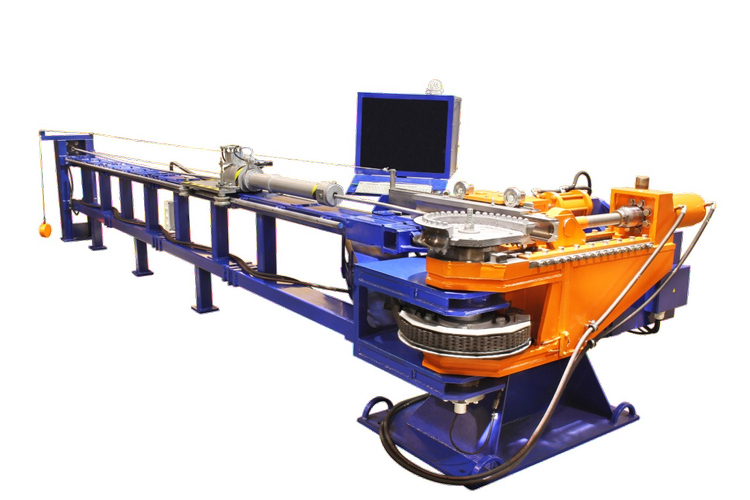
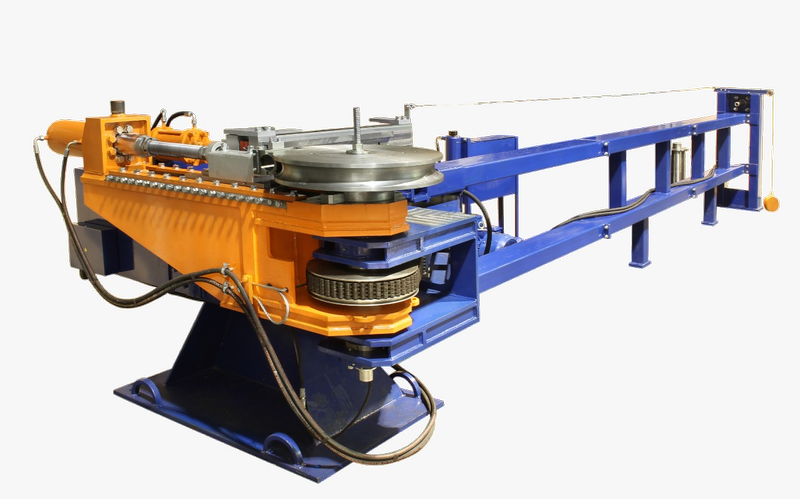


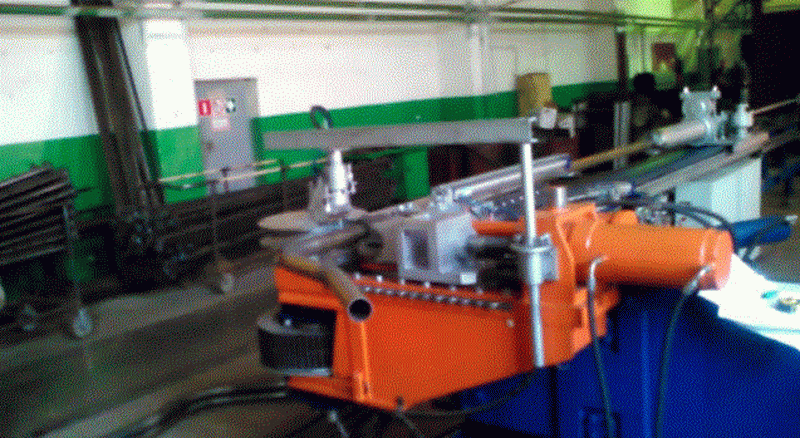
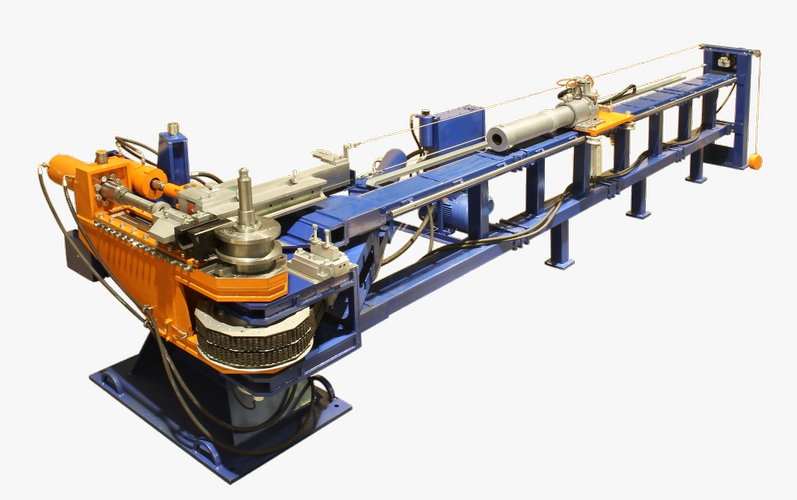
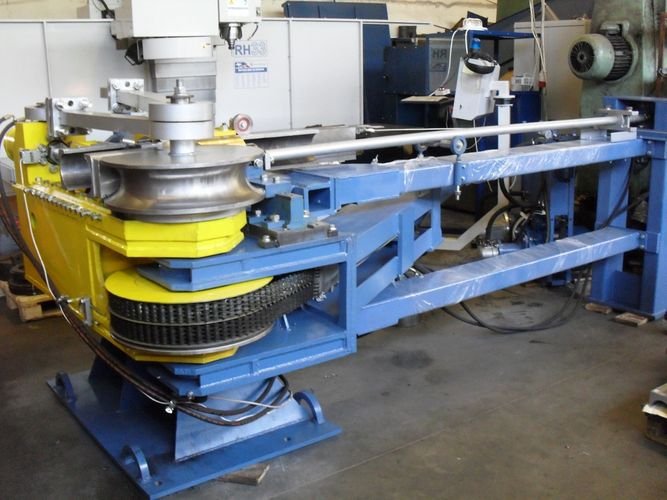
|
Tube bending machine T-76 semi-automatic design with indication and programmable automatic clamps for linear movement and rotation of the tube in space, right bending |

|
Machines of this class are an excellent alternative to bending machines with heating, having undeniable advantages in bending speed and cost price. In addition, it should be borne in mind that in some cases cold bending is the only possible solution, since heating can be excluded for technological reasons.
Power machines, possessing high power characteristics, at the same time have relatively low weight (up to about 5 tons) and can be (by load) installed on almost any floor.
Traditionally, tube benders are named according to the largest diameter of the bent tubes.
The ability of the machine to bend a tube depends on:
- torque on the bending shaft;
- design parameters that allow you to place a tube of the required size in the machine;
- quality of machine drives, providing the required bending modes;
- the possibility of installing modern tools on the machine;
- high rigidity of machine units, which is especially difficult to do with high required bending forces;
this, in particular, distinguishes highly professional machines (such as ours), from hack from a well-known country and amateur "pioneer" handicrafts.
The main power parameter of a general industrial machine tool is the torque on the main shaft. We conditionally classify machines with a torque exceeding 15,000 as power machines N*m (about 1.5 tonn*m - since large numbers are long pronounced and beloved, we use the term "tonn*m", assuming it to be approximately 10,000 N*m).
Sometimes some manufacturers misuse the names and name the machines (or indicate their parameters) with an overestimation of the tube diameter. In this case, the torque (the main characteristic of the machine) often not specified at all. In practice, this leads to the fact that the company that bought the machine discovers that the largest tube, indicated in the passport or name, although it can be bent, but, at best, a much larger radius than expected. In the worst case, the tube does not bend at all.
We always indicate the power parameters of the machines and give the characteristics of the tubes, which can be bent on our machines.
The tradition of our company is such that we quote these figures with some reserves. This means that each machine is actually capable of developing a force slightly more than indicated.
All tube bending machines can be supplied in versions from simple semi-automatic to fully automatic.
The main parameters of power tube bending machines are shown in the following table.
In order to correctly understand this table, please see the explanations of the parameters indicated in it (they are given below the table).
| Parameter | T-76 | T-90 | T-108 | T-114 |
| Rated maximum torque on the bending shaft of the machine, (tonn*m) | 2.5 | 4 | 6 | 8 |
| Largest diameter of tubes | 76 mm | 90 mm | 108 mm | 114 mm |
| Smallest diameter of tubes | not limited by the construction | |||
| Largest bending radius |
modification: 400 mm 600 mm 800 mm |
modification: 450 mm 600 mm |
modification: 500 mm 600 mm |
modification: 500 mm 650 mm 800 mm |
| can be increased by request | ||||
| Smallest bending radius | not limited by the construction | |||
| Tube length for mandrel bending | usually 6000 mm can be increased or decreased by request |
|||
| Approximate Mass (kg) | 3500 | 4000 | 4500 | 5000 |
Torque on the bending shaft of the machine -
the most important characteristic of the machine, which allows you to really (!) compare machines with each other, and also giving, given the knowledge and experience of work, the ability to determine which product can be bent on the machine.
The fact is that many manufacturers hide this value and issue instead of it, for example, this ("The machine can bend tubes up to 76 mm with a wall thickness up to 3 mm"). This characterization actually says almost nothing. This does not even mean that YOUR 76x3 tube can be bent on the machine. (and what about, for example, the bending radius? the tube's material? all these factors are important).
The required bending force can be very different from the theoretical bending force. Therefore, the machine, positioned by one manufacturer as the 76 mm, may in fact be weaker than a machine positioned by another manufacturer, like the 63 mm.
It should not be confused with another - the moment of resistance, often indicated by some manufacturers. The fact is that the calculation based on the moment of resistance can be unpleasantly misleading, since very large losses of effort are spent on overcoming the friction of the tool against the tube, etc. For example, in some cases, we take a net bend safety factor of 2.5 (!).
It is possible to determine exactly whether this particular product can be bent on this particular machine, after consulting with us:
|
|
|
|
+372 5853 8105 |
|
m@BaltMind.com |
Maximum diameter of bent tubes -
in this concept we put a purely geometric meaning - it means that tubes with diameters not exceeding the specified one are easily put on the bending machine;
at the same time it gives a rough estimate of the tube that can be bent on the machine;
in any case, we do not know a machine in the world (!) which surpasses our machines in this parameter; that is, if we are talking about the T-XXX machine, then we do not know a stronger machine in the world, which would be called a XXX machine tool.
Smallest diameter of bent tubes -
is not structurally limited on our machines - theoretically, it is possible to bend wire; but we must remember about the bending of thin tubes under their own weight - we have special solutions for this case (consult us).
Largest bending radius -
can usually be increased to the customer's need, usually increasing it to 600 - 800 - 1000 mm is not a problem
Smallest bending radius -
is not structurally limited, it is determined by the bending technology. Current standards provide for 1.5 D tubes. When bending with a booster, a 1D radius or some less can be achieved. The absence of design constraints is very important - for example, on many machines, the tool is mounted on a shaft of a certain diameter. Accordingly, on such machines, it is impossible to make a bend with a radius less than a certain radius. (determined by the shaft diameter). There is no such restriction on our machines, the smallest bending radius is not limited by the machine's construction.
Maximal bending angle -
maximal angle the bending disc can be turned; in the usual case, it is 190-195 degrees, i.e. to a 180-degree angle for bend (for springing the tube) we leave 10-15 degrees, which is almost always more than enough. This does not mean that products with large angles cannot be bent - special equipment is used for this - consult us.
Tube length for mandrel bending -
tube length from the beginning of the first bend to the end of the tube (that is, the tube itself can be even longer); our machines are made on a modular basis, if necessary, the maximum tube length can be significantly increased, for example, we produced machines for mandrel bending of tubes with a length of 12 m.
Tube length for mandrelless bending -
unlimited.
|
Tube bending machine T-76 for tubes up to 8 m |

|
Bending angle accuracy -
typically 0.1 degrees; in fact, almost all serious machine tool manufacturers give an accuracy of 0.1 degrees; This is due to the empirical reasonableness of this accuracy - on real tubes, the error in the linear deviation of the tube ends, admissible from the point of view of their application, when converted into angles gives approximately this value, which means that getting a lot is impractical; the accuracy can be increased to the required by the customer.
Working fluid -
Conventional hydraulic oils readily and universally available.
Volume of working fluid -
about 50 L - this is not a typo, the amount of oil for this class of machines is really extremely small (usual values - 200 L and above); such a small volume is possible thanks to the correct and well-thought-out design of the machine hydraulics and control system.
Power supply -
normal, AC. Power supply from one phase is also possible. And, even if you have absolutely poor nutrition, the operation of the machine is still possible, in this case, we install special power protection.
Drive type -
electro-hydraulic - in general, the drive is our problem, they should not become customer problems. The drive must provide the characteristics of the machine, be reliable, easy to operate, and cheap to repair after many years. Therefore, we do not write phrases like "the hydraulic servo drive of the company *** ensures high bending accuracy", designed for the purely advertising effect of "buzzwords". We say simply - the drive we use is simple, unpretentious, elementary in maintenance, reliable in any conditions, and extremely cheap to repair. In doing so, it gives the specified accuracy and speed. You can easily verify all this for yourself.
Maximum bending speed -
is directly related to the power of the machine;
in theory they are related by a simple relationship:
power = torque * bending speed
In practice, corrections are made for friction losses (all types).
Drive power -
can be anything - practically from 2 kW and above - we can even choose this value at the request of the customer, based on the power available to him and the productivity he needs. In principle, there is no problem bending a tube with a diameter of 219 mm with a single-phase zero-phase electric machine, but it will work slowly.
Node Layout -
the control panel and the oil station can be installed by the customer in a convenient place, which reduces the requirements for the premises; they are connected to the machine with a wire that can be easily connected and disconnected.
Approximate Weight -
The mass of the machine is highly dependent on many parts, in particular, the maximum length of tube length, maximum bending radius, level of automation.
|
|
|
|
+372 5853 8105 |
|
m@BaltMind.com |
© All rights reserved, 1993 - 2025.
 Беларуская
Беларуская
 Eesti
Eesti
 Suomen
Suomen
 Français
Français
 Қазақ
Қазақ
 Lietuvių
Lietuvių
 Latviešu
Latviešu
 Polski
Polski
 Русский
Русский
 Українська
Українська